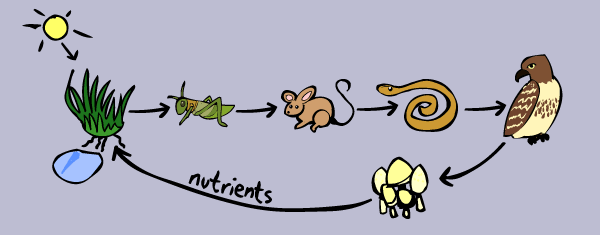Food Chains
A food
chain represents the transfer of energy through a series of organisms in a
community (a group of organisms living in the same environment).
It
usually starts with a producer (an organism that manufactures simple food by a
process such as photosynthesis) and ends with a top consumer. Producers are
eaten by herbivores or primary consumers. Carnivores may be secondary, tertiary
or Quaternary consumers.
Bigger Food Chains
Here's another food chain, with a few more animals. It starts with acorns, which are eaten by mice. The mice are eaten by snakes, and then finally the snakes are eaten by hawks. At each link in the chain, energy is being transferred from one animal to another.

There can be even more links to any food chain. Here another animal is added. It goes
Grass to grasshopper to mouse to snake to hawk.
There is actually even more to this chain. After a hawk dies, fungi (like mushrooms) and other decomposers
break down the dead hawk, and turn the remains of the hawk into
nutrients, which are released into the soil. The nutrients (plus sun and
water) then cause the grass to grow.
It's a full circle of life and energy!!

So food chains make a full circle, and energy is passed from plant to animal to animal to decomposer and back to plant! There can be many links in food chains but not TOO many. If there are too many links, then the animal at the end would not get enough energy.
For further information Food Chain please follow the link below:
http://www.enchantedlearning.com/subjects/foodchain/


No comments:
Post a Comment